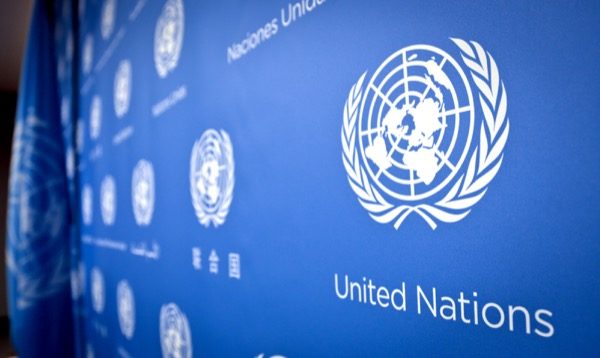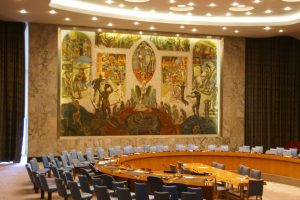
(AP Photo/Bebeto Matthews)
Establishment
The League of Nations
The world witnessed the barbaric cruelties of World War I which developed the need for there to be an organisation to ensure that peace was maintained. One of the greatest proponents for this was then US President Woodrow Wilson who called for a ‘general association of nations.’ In 1919 during the Paris Peace Conference, the Covenant for what would become the League of Nations was drafted and included in the Treaty of Versailles, a peace treaty between Germany and the Allied Powers. The League of Nations officially began on January 10, 1920.[1]
The United Nations
During World War II, the major nations agreed that a new organisation was needed for the establishment of peace and managing international affairs. Franklin D. Roosevelt and Winston Churchill led the charge. ‘United Nations’ originally referred to the 26 countries allied against Germany, Italy and Japan. Later, the United Nations Conference on International Organization was held in San Francisco in April 1945 where the final Charter was drafted. This was when veto power was given to the permanent members. The UN officially began on October 24, 1945. [2]
Objective
The League of Nations
‘…to promote international co-operation and to achieve international peace and security
by the acceptance of obligations not to resort to war, by the prescription of open, just and honourable relations between nations, by the firm establishment of the understandings of international law as the actual rule of conduct among Governments, and by the maintenance of justice and a scrupulous respect for all treaty obligations in the dealings of organised peoples with one another…’[3]
The United Nations
‘…to save succeeding generations from the scourge of war, which twice in our lifetime has brought untold sorrow to mankind, and to reaffirm faith in fundamental human rights, in the dignity and worth of the human person, in the equal rights of men and women and of nations large and small, and to establish conditions under which justice and respect for the obligations arising from treaties and other sources of international law can be maintained, and to promote social progress and better standards of life in larger freedom…’[4]
Organs
The League of Nations
The Assembly:
Comprised all member states and served as the main representative body of the League of Nations. It had a broad mandate, such as discussing matters of world peace, admitting new members, the budget etc. All decisions were based on the unanimity rule – any vote against would nullify the decision
The Council:
Had four permanent members (Britain, France, Italy, Japan) and four members elected every three years. It monitored matters of world peace, implemented financial sanctions, made plans for reducing armaments amongst other things. Members had veto power, and so unanimity was required in all decisions. This often often delayed matters rather than leading to swift and decisive decisions
The Secretariat:
Led by a Secretary-General who led humanitarian agencies as well as the League’s court of justice.[5]
The United Nations
The General Assembly:
Includes all 193 member states. It is the main deliberative and policy making organ of the UN, deciding on important matters of peace, membership, budget etc. Decisions require a majority vote.
The Security Council
Comprises 5 permanent members and 10 elected members. Serves the primary purpose of maintaining international peace and security. Seeks peaceful resolution to conflict and can even impose sanctions. Each permanent member has veto power.
Economic and Social Council
Reviews and discusses policies relating to economics.
International Court of Justice
Primary court of the United Nations which settles disputes according to international law and provides advisory opinions.
The Secretariat:
Headed by the Secretary-General, carrying out the daily affairs of the United Nations.[6]
Failures
The League of Nations
In the words of Winston Churchill:
‘[T]he League did not fail because of its principles or conceptions. It failed because those principles were deserted by those states which brought it into being, because the governments of those states feared to face the facts and act while time remained.’
Britain and France, the two most influential members undermined its authority in order to appease Hitler, after which the Second World War broke out, proving that the League of Nations was truly ineffective. [7]
The United Nations
According to The New York Times:
‘Today, the United Nations can, to some, seem to serve the narrow national interests of its 193 member countries – especially the most powerful ones – and not ordinary citizens. These parochial priorities can stand in the way of fulfilling the first two pledges of the Charter: to end “the scourge of war” and to regain “faith in fundamental human rights”’… ‘The [Security] Council has been feckless in the face of major conflicts, particularly those in which permanent members have a stake.’ [8]
ENDNOTES
[1] https://www.britannica.com/topic/League-of-Nations/The-Covenant#
https://www.ungeneva.org/en/about/league-of-nations/background
[2] https://www.britannica.com/topic/United-Nations#ref12399
[3] https://www.ungeneva.org/en/about/league-of-nations/covenant
[4] https://www.un.org/en/about-us/un-charter/full-text#:~:text=To%20achieve%20international%20co%2Doperation,%2C%20language%2C%20or%20religion%3B%20and
[5] https://www.ungeneva.org/en/about/league-of-nations/organs
https://www.britannica.com/topic/League-of-Nations
[6] https://www.un.org/en/about-us/main-bodies#:~:text=The%20main%20bodies%20of%20the,Organization%20was%20founded%20in%201945.
[7] https://www.ungeneva.org/en/about/league-of-nations/transition
https://www.bbc.co.uk/bitesize/guides/zbg4t39/revision/9#
[8] https://www.nytimes.com/2016/09/19/world/what-is-united-nations-un-explained.html


Add Comment